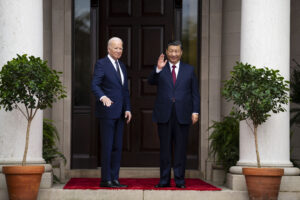U.S.-Russia Nuclear Arms Racing: Still Crazy After All These Years
For most Americans, the emergence of a renewed nuclear arms race with Russia comes as a surprise. This July 16, 1945, photo shows the mushroom cloud of the first atomic explosion at Trinity Test Site, New Mexico. (AP)
This July 16, 1945, photo shows the mushroom cloud of the first atomic explosion at Trinity Test Site, New Mexico. (AP)
President Vladimir Putin’s major address on March 1 to Russia’s Federal Assembly was candid about the economic and social challenges facing Russians. What attracted attention in the United States, however, was a detailed description, complete with video animations, of an array of new nuclear weapons delivery systems, including a nuclear-powered cruise missile and an underwater drone.
A month earlier, on Feb. 2, the Trump administration released its Nuclear Posture Review. The review’s assessment of prospects for U.S.-Russian nuclear arms control is grim. It proposes two new capabilities, both aimed at Russia, a low-yield warhead deployed on submarine-launched missiles, and a sea-based, nuclear-armed cruise missile. It also endorses existing plans to sustain and upgrade existing nuclear forces and infrastructure to the tune of well over a trillion dollars over the next three decades.
While not as sensational as the weapons described by Putin, the Pentagon’s proposals manifest a commitment to an increasing and long-term reliance on nuclear arms. The review also lowers the threshold for use of nuclear weapons, emphasizing the role of such weapons in responding to “non-nuclear strategic attacks,” notably cyberattacks. The recommendation for increased nuclear weapons spending comes at a time when Congress has approved a budget deal providing for military spending of $700 billion in 2018 and $716 billion in 2019, figures well above those in play just last year.
For most Americans, the emergence of a renewed nuclear arms race with Russia comes as a surprise. Since the end of the Cold War, public discussion about nuclear weapons in the U.S. has been dominated by purported threats of nuclear weapons in the hands of nonstate actors or regional adversaries. In 2010, President Barack Obama proclaimed: “Today, the threat of global nuclear war has passed, but the danger of nuclear proliferation endures. …” As recently as 2013, the Defense Department declared the most pressing nuclear dangers to be proliferation and “nuclear terrorism.”
The crisis precipitated by the 2014 overthrow of Ukraine’s government and Russia’s annexation of Crimea was, for the U.S. public, the first intimation that great-power nuclear arsenals still pose catastrophic dangers. For the first time since the Cold War, Russian and American nuclear-armed forces were conducting exercises and patrols in the same region, while each backed opposing factions in a civil war. As the Ukraine confrontation settled into a tense stalemate, it disappeared from the front pages along with the dangers posed by the immense nuclear arsenals still deployed by the U.S. and Russia. Donald Trump’s ascendance, featuring disturbingly misinformed campaign comments and then his profoundly alarming confrontation with North Korea, brought nuclear weapons back into mainstream public discussion—but U.S. and Russian nuclear forces still remained in the background, out of focus.
Origins of the Current Confrontation
Despite appearances, plans for new Russian nuclear weapon systems are not a response to the Nuclear Posture Review or to Trump’s casual rhetoric about U.S. nuclear might. The causes of the resurgent confrontation between the two countries that possess over 90 percent of the world’s nuclear weapons extend back decades, to decisions made in the early 1990s. The disintegration of the Soviet Union also marked the end of the Cold War—a titanic, half-century confrontation for which no formal settlement ever was negotiated, only a series of piecemeal arms control measures and political agreements. The spirit and in some cases the letter of this partial Cold War settlement was ignored by the U.S. and its NATO allies.
Instead of engaging Russia as a partner in a new, potentially more cooperative order, they instead took every opportunity to exploit the political and economic weakness of the post-Soviet states. Despite assurances from Western governments that NATO would not be expanded to the East, the military alliance now includes not only many of Russia’s former Warsaw Pact allies but also the former Soviet republics of Estonia, Latvia and Lithuania. Even today, NATO membership for Georgia remains on the table, and an effort at some point to include Ukraine is not out of the question.
NATO’s expansion eastward proceeded in tandem with the economic subordination of former Warsaw Pact countries. It was driven as well by the interests of Western arms makers seeking new markets for their wares, and new rationales for endless high-tech weapons development in a post-Cold War world. For them, the confrontational aspect of NATO expansion was and continues to be an opportunity, not a risk.
Confident that Russia no longer presented a significant military challenge, both Republican and Democratic administrations squandered the crucial post-Cold War opportunity to eliminate the existential threat to humanity posed by huge nuclear arsenals. Beginning in the mid-1990s, when Russian economic and military power was at its nadir, the United States embarked on a long-term effort to modernize its nuclear weapons, as well as the laboratories and factories that sustain them. U.S. military spending began to climb out of its brief post-Cold War trough at the same time, with the U.S. developing and deploying an array of powerful, accurate conventional armaments and stealthy delivery systems. Many of these were battle-tested in the wars that the U.S. has been conducting continuously since 1991. These conventional systems, which could destroy some targets previously only vulnerable to nuclear weapons, were seen as a strategic threat by both China and Russia.
Meanwhile, the U.S. nuclear weapons modernization program was applying incremental upgrades to warheads and delivery systems. Perhaps most important of these was an upgrade of submarine-launched ballistic missile warheads beginning in 2009 that increased their capability to destroy hardened targets like missile silos and command centers. Long-time observers of U.S. nuclear weapons programs characterized the changes as “revolutionary new technologies that will vastly increase the targeting capability of the U.S. ballistic missile arsenal.” They concluded: “This increase in capability is astonishing—boosting the overall killing power of existing U.S. ballistic missile forces by a factor of roughly three—and it creates exactly what one would expect to see, if a nuclear-armed state were planning to have the capacity to fight and win a nuclear war by disarming enemies with a surprise first strike.”
Despite its unparalleled conventional military dominance in the wake of the Soviet Union’s collapse, the U.S. government failed to seize the opportunity to pursue elimination of nuclear weapons or at least the reduction of arsenals to very low levels. Informal agreements in the early 1990s took entire categories of tactical nuclear weapons out of service, but still left large numbers of operational nuclear weapons deployed. Although negotiations continued throughout the 1990s, no new bilateral arms control treaty entered into force. Subsequently, the Russia-U.S. nuclear arms agreements completed during the Bush and Obama administrations did little to change the fundamental character of either country’s nuclear arsenal, leaving in place forces still capable of ending human civilization in short order.
In an early sign of an emerging U.S. rejection of multilateral approaches to arms control, in 1999 the Senate refused to approve ratification of the Comprehensive Nuclear-Test-Ban Treaty (CTBT). In 2000, Russia ratified the treaty. Since then it has periodically stressed that U.S. ratification is essential to advancing nuclear disarmament and global security. A commitment to complete negotiation of the CTBT had been central to a 1995 decision to extend indefinitely the Nuclear Non-Proliferation Treaty (NPT). The current Nuclear Posture Review says that the U.S. will not ratify the CTBT, and does not rule out resumption of nuclear explosive testing.
U.S. Withdrawal From the ABM Treaty
In late 2001, the Bush administration announced that the U.S. was withdrawing from the Anti-Ballistic Missile (ABM) Treaty, which since 1971 had placed stringent limits on U.S. and Russian missile defenses. Just a year and a half earlier, the U.S. under the Clinton administration, Russia, and other participating states had agreed to a commitment in an NPT review outcome document to “preserving and strengthening the [ABM Treaty] as a cornerstone of strategic stability and as a basis for further reductions of strategic offensive weapons.”
In his 2018 annual presidential address, Putin characterized the ABM Treaty in similar fashion, stating that Russia saw it as “the cornerstone of the international security system.” Together with U.S.-Russia agreements limiting nuclear arms, said Putin, “the ABM Treaty not only created an atmosphere of trust but also prevented either party from recklessly using nuclear weapons, which would have endangered humankind, because the limited number of ballistic missile defense systems made the potential aggressor vulnerable to a response strike.” As Putin said, and as former Russian Foreign Minister Igor Ivanov elaborated, Russia made strenuous attempts to dissuade the U.S. from ending the ABM Treaty, and subsequently sought to make new arrangements limiting missile defenses, all to no avail.
Putin portrayed the continuing development and ever wider deployment of U.S. ballistic missile defense systems in the wake of the U.S. termination of the ABM Treaty as a growing threat: “However, in light of the plans to build a global anti-ballistic missile system, which are still being carried out today, all agreements signed within the framework of New START are now gradually being devaluated, because while the number of carriers and weapons is being reduced, one of the parties, namely, the U.S., is permitting constant, uncontrolled growth of the number of anti-ballistic missiles, improving their quality, and creating new missile launching areas. If we do not do something, eventually this will result in the complete devaluation of Russia’s nuclear potential.”
U.S. officials over the years have maintained that U.S. missile defenses pose no threat to Russia’s nuclear forces due to their large number of deliverable warheads. But the Russians have some reason for concern. Together with U.S. nuclear warhead upgrades that put Russia’s missile silos and command centers at risk, unlimited development of ballistic missile defense systems, despite the technical challenges, in the long run perhaps could threaten Russia’s primarily land-based nuclear forces. Even moderately effective missile defenses that could significantly limit a depleted second strike would complicate an already dangerous strategic calculus, perhaps raising incentives on both sides to strike first and harder in a crisis.
U.S. development and deployment of missile defenses already have had deleterious effects on nuclear arms control. Following the conclusion in 2010 of negotiations on New START, which yielded modest reductions in deployed long-range, “strategic” nuclear weapons, Russia refused engagement on the ambitious follow-on program of bilateral nuclear arms reductions—to include non-strategic nuclear arms and, for the first time, verified dismantlement of warheads—proposed by the Obama administration. As Russian representatives repeatedly explained, concerns motivating its position included U.S. missile defense programs and development of U.S. conventional long-range strike capabilities. The Russian position was deplorable, but it was also predictable.
Russia’s Plans for New Nuclear Weapons Systems
It is against this background that Putin announced the development of Russia’s new nuclear weapons delivery systems. All of the new systems were framed as means to evade existing missile defenses, which are designed primarily to target ballistic missiles that follow a high-arcing, non-maneuvering flight path. These include a new, very long-range, multiple warhead missile that could take unconventional flight paths; a hypersonic, maneuvering air-launched cruise missile; and a gliding, maneuverable hypersonic delivery vehicle with a non-ballistic flight path. Similar hypersonic technologies, it should be noted, are being researched or are under development by both the U.S. and China.
Two more exotic systems that caught the attention of both specialists and the general media are nuclear-powered cruise missiles that are claimed to have unlimited range and nuclear-powered “unmanned underwater vehicles.” Putin characterized the unmanned submersible vehicles as suitable for attacking a range of targets, including “coastal fortifications and infrastructure,” and stated that the “the tests that were conducted enabled us to begin developing a new type of strategic weapon that would carry massive nuclear ordnance.” Although similar concepts had been explored by the U.S. and the Soviet Union (and in the case of a nuclear-armed torpedo designed to destroy shore installations, even briefly deployed by the Soviet Union), they struck many observers as outlandish.
Detonating a “massive nuclear ordnance” at harbor level would devastate any harbor city, and would mobilize immense amounts of radioactive debris into the atmosphere. A nuclear-powered cruise missile likely would leave a trail of radioactive contamination in its wake, and would be dangerous even to flight test (what happens, for example, at the end of the test?). Some speculated that they might be “Potemkin village” weapons, propaganda creations intended to underscore the Russian leadership’s displeasure with U.S. policies or ersatz chips to be bargained away in some future round of arms control negotiations.
Aside from arguable marginal scenarios, the use of nuclear arms of any type would violate international humanitarian law. That law requires the use of violence in war to be necessary, proportionate, and discriminate, with effects on both civilian populations and the natural environment part of the assessment. The U.S. Nuclear Posture Review asserts in passing that “the conduct of nuclear operations would adhere” to those requirements. On the contrary, above all, nuclear weapons cannot be used in compliance with the requirement of discrimination, because their massive and uncontrollable effects—blast, heat, short- and long-term radiation, and, in urban areas, firestorms—make it impossible to distinguish between military targets and civilian populations and infrastructure.
The Treaty on the Prohibition of Nuclear Weapons was negotiated in 2017 by 122 states, not including, however, any nuclear-armed states. Its preamble “considers” that use of nuclear weapons would violate international humanitarian law and “reaffirms” that such use “would also be abhorrent to the principles of humanity and the dictates of public conscience”—factors with legal as well as moral value.
As the treaty’s reference to “principles of humanity” suggests, in many circumstances, certainly in attacks on cities, use of nuclear weapons goes so far beyond the boundaries of warfare that it likely would constitute not only violations of international humanitarian law but also crimes against humanity as most recently defined in the Statute of the International Criminal Court. Use of a submersible drone carrying “massive nuclear ordnance” and of the radiation-trailing nuclear-powered cruise missile are examples—not the only ones—of this extreme deviation from the normal conduct of warfare. They likely would only be used in general nuclear war, and in this sense are true “doomsday” weapons. Even designing them is an implicit acknowledgement that once nuclear weapons are used, even in “limited” fashion, escalation may be difficult or impossible to control.
Erosion of International Law
There is another extremely important component of international law that Putin’s speech and the Nuclear Posture Review blatantly disregard. That is the obligation under Article VI of the Non-Proliferation Treaty “to pursue negotiations in good faith on effective measures relating to cessation of the nuclear arms race at an early date and to nuclear disarmament.” According to a unanimous conclusion of the International Court of Justice in its 1996 Advisory Opinion, “Legality of the Threat or Use of Nuclear Weapons,” the obligation requires states “to pursue in good faith and bring to a conclusion negotiations leading to nuclear disarmament in all its aspects.” The obligation was reinforced by an NPT review conference “unequivocal undertaking … to accomplish the total elimination” of nuclear arsenals. It was to be implemented in part through fulfillment of another review conference commitment, diminishing the role of nuclear weapons in order to minimize the risk of their use and to facilitate disarmament.
The Russian and U.S. plans for new nuclear weapons systems—and the lack of negotiations about them—plainly violate the obligation regarding “cessation of the nuclear arms race at an early date,” as well as the commitment to reduce the role of nuclear weapons. The U.S. expansion of the circumstances in which nuclear weapons might be used additionally violates that commitment.
Moreover, the clear intent of both Russia and the U.S. to maintain large, diversified nuclear forces for decades to come betrays a lack of good faith in relation to the obligation to negotiate the elimination of nuclear arsenals. In the case of the United States, the Nuclear Posture Review fails to identify any concrete steps to pursue on nuclear arms control and disarmament. As to the U.S.-Russian relationship, emphasis is placed upon a claimed Russian violation of the Intermediate Nuclear Forces Treaty. The review does not even endorse extension of New START for five years when it expires in 2021, a step which Russia has supported. Additionally, in his speech Putin said: “Let us sit down at the negotiating table and devise together a new and relevant system of international security and sustainable development for human civilization.” Rhetoric perhaps, but why not test it?
Whether or not Russia’s program to develop nuclear-powered cruise missiles and underwater drones delivering massive nuclear warheads are “real,” even the fact that one of the world’s two leading nuclear-armed states is willing to threaten to build them is a worrisome development. It is a definitive marker that what opportunity there was in the post-Cold War period to eliminate humankind’s self-created mechanism of annihilation on a civilization scale was missed. We are in a new, far more dangerous age, and must discover anew the urgency of nuclear disarmament, and again take the first tentative steps that might lead us there.
Both Russia’s program and the Nuclear Posture Review display a kind of contempt for treaty obligations and for international law generally, underscoring an observation by the International Court of Justice in its 1996 opinion that today seems prophetic: “In the long run, international law, and with it the stability of the international order which it is intended to govern, are bound to suffer from the continuing difference of views with regard to the legal status of weapons as deadly as nuclear weapons.”
Twenty-two years later, the corrosive effect on international law and the stability of the international order of nuclear weapons and differing views regarding who is entitled to have them is evident. Nuclear weapons and the threat of their proliferation has been used as a stalking horse for the geopolitical agendas of the world’s most powerful states. It has sparked an unlawful war based on questionable intelligence. In the confrontation between the United States and North Korea, it has brought us again to the brink of war between nuclear-armed countries.
As the court concluded: “It is consequently important to put an end to this state of affairs: the long-promised complete nuclear disarmament appears to be the most appropriate means of achieving that result.”
The interests of the world’s populations and their governments are as far apart as they have been in a long time. This reflects the growing disparities in wealth and power between those who rule and the rest of us, and the erosion of what democracy had been achieved. Extreme nationalist elements are ascendant worldwide, their common characteristic being a politics that redirects the emotions evoked by those developments—fear, resentment, and a pervasive sense of loss—against vulnerable minorities at home and enemies abroad. Authoritarian nationalists are in power in Russia and in several ex-Warsaw Pact NATO states, and also hold the presidency and constitute a substantial, perhaps dominant, portion of the majority party in the Congress of the United States.
The revanchist intentions of Russia’s government and ruling oligarchs have been exaggerated in the U.S. press due to the peculiar entanglement of U.S.-Russia relations with domestic partisan politics in this moment. This does not mean, however, that no such aims exist. Neither the elites nor the general populations of Eastern Europe see renewed Russian dominance as an attractive option, and authoritarian nationalist governments in front-line NATO states have their own reasons for whipping up fear of a resurgent Russia. Beyond Europe, there are other regions where encounters between U.S. and Russian policies and deployed forces could go awry, from Syria to the border most forget Russia shares with North Korea. With a U.S. government that appears adrift at the top but that still possesses a formidable and well-organized military, this is a combustible mix, with ample opportunities for each side to misjudge the intentions, and the fears, of the other.
The Nuclear Dilemma
The Korea crisis, and the recent hopeful signs regarding its resolution, should be taken as both an urgent warning and as an opportunity to rethink the meaning of nuclear weapons. We will never know how close to disaster we have come in recent months, and still may come. As that danger grew, discussion of the immeasurable horrors of a full-scale warfare between two large modern militaries in densely populated Northeast Asia—even if nuclear weapons were not used—grew more concrete. A full-scale war between Russia and the United States would dwarf our worst imaginings about war between the U.S. and its regional allies and North Korea.
In thinking about the deeper nature of our nuclear dilemma, it is significant that South Korea has taken the lead in seeking—and, as it looks now, achieving—a diplomatic breakthrough with its North Korean counterparts that could end the immediate crisis, and that might lead eventually to a more lasting peace on the peninsula. As was the case for Europeans during the Cold War, South Koreans found themselves trapped between nuclear-armed adversaries, one an ally. And as was the case of NATO countries hosting U.S. nuclear missiles, they faced the possibility that a nuclear war could be fought on their soil without their own government’s consent. This raises a question seldom asked by inhabitants of nuclear-armed countries: Whose nuclear weapons are they, really? Whose interests do they protect?
This question then leads naturally to others. As E.P. Thompson, a founder of European Nuclear Disarmament, asked in 1981 in “A Letter to America,” “Is nuclear war preferable to being overcome by the enemy? Are the deaths of fifteen or twenty million and the utter destruction of the country preferable to an occupation which might offer the possibility, after some years, of resurgence and recuperation?” and finally, “Are we ourselves prepared to endorse the use of such weapons against the innocent, the children and the aged, of an ‘enemy’?” The people of every nuclear-armed country should be asking these questions today.
There are other lessons we should have learned by now. No system or country is immune to corruption, or collapse. No country can guarantee that a class of leaders will not rise to power who are shortsighted and self-serving, and who place their own welfare above that of their people, or of humanity itself. No system or “way of life” is so perfect that its preservation merits risking humanity’s future, and thinking it to be so is a form of madness. Recent events may have sharpened our focus on these realities, but they have been true all along. Nuclear weapons are unsafe in any hands.
Your support matters…Independent journalism is under threat and overshadowed by heavily funded mainstream media.
You can help level the playing field. Become a member.
Your tax-deductible contribution keeps us digging beneath the headlines to give you thought-provoking, investigative reporting and analysis that unearths what's really happening- without compromise.
Give today to support our courageous, independent journalists.






You need to be a supporter to comment.
There are currently no responses to this article.
Be the first to respond.